No matter how good a care you take of your guns, there’s always a chance that they’ll get a little bit of rust on them. You forget to clean your gun after a hunt, you get caught in the rain, or your body’s sweat on your daily carry gun starts to cause a little bit of rusting.
Both the salt in our sweat and the acid in the oils that our bodies secrete are highly corrosive to steel; and while the coatings that gun manufacturers put on guns are intended to fight corrosion, they aren’t perfect. Besides, they can wear off, leaving the metal totally unprotected.
In my own case, my former concealed carry gun was a pocket gun, carried in a padded cloth holster in my front pants pocket. Since I live in a hot climate, it was exposed to a lot of perspiration.
At the same time, I didn’t want the gun to be oily on the outside, as that would stain my pants. My current concealed carry gun is in an outside waist holster, but is still exposed to a lot of perspiration, as well as wear.
The only good thing I can say about that is that the rust that forms in places where the finish has worn off also tends to wear off, leaving bare steel.
Before anyone bothers getting after me about not taking care of my guns, I freely admit that I don’t clean and/or oil them as often as I should. I could give excuses, like being busy; but I won’t bother. I know I’m not doing what I should and you know it; that’s enough.
Related: What Kind Of Guns Are Best Stored To Leave As An Inheritance
Both of these pistols, like most guns that develop rust on them, only have surface rust, which one has to look carefully to see, as it looks more like pitting than anything else, as seen on the Ruger LCP slide below. But this is the case of most guns that any of us would be trying to remove rust from.
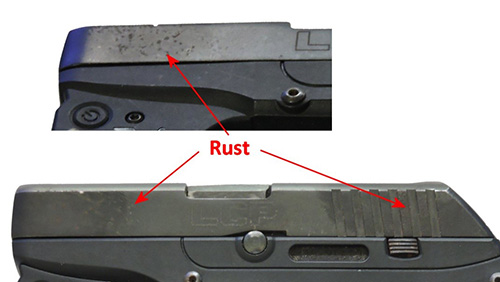
The only place obvious rust is likely to appear is in an inside corner, where nothing could wear against it, such as in the case of the front sight below.
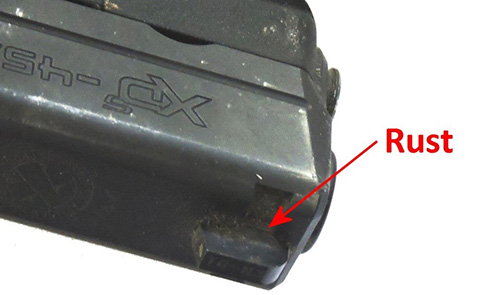
A really rusty gun, like what comes to mind when the term “rusty gun” is used, is probably only going to be encountered hiding in your grandparent’s basement, where it was forgotten.
Care must be taken in removing rust and restoring these firearms, as improper rust removal, while effective, might destroy their value.
A Bit About Coatings
Guns today come with various different coatings on them, all intended to protect the gun from rusting. Some coatings are better at this than others, but can also have the effect of changing the gun or gun part’s overall dimensions.
I remember a friend, a gun shop owner, who was building a custom 1911. Several of the parts had been gold plated and wouldn’t fit back together. That’s because plating a metal part adds material over what is already existing, changing the overall dimensions.
Some of the more common coating are:
Black Oxide (Bluing)
The traditional finish for firearms is bluing, more technically known as black oxide. This method protects from rusting, as well as reducing glare off of the metal.
It is achieved through an electromechanical reaction, transforming the surface of the metal to magnetite, an iron ore. The chemical formula for magnetite is Fe3O4, compared to rust, which is Fe2O3.
Black oxide finish won’t chip off of a gun, although it can wear off. It doesn’t change the physical dimensions of the part. Being about the lowest cost means of finishing a gun, black oxide is very common.
Hard Anodize (Hard Coat)
The hard anodizing process is another electrochemical process used for the finish of firearms. However, it is pretty much only used on aluminum, as hard anodizing causes most types of steel to rust, rather than to be converted to a hard coating.
Anodizing does affect the physical dimensions of the part, so that must be taken into account when the parts are made. The AR-15 receiver is the most common gun part to be anodized.
Manganese Phosphate (Parkerize)
Steel can also be phosphate coated, producing what is commonly known as Parkerizing. The original M-16, first issued during the Vietnam War was Parkerized.
This produces a superior coating, which is much more durable than bluing. To Parkerize metal, it is submersed in a phosphoric acid solution. This creates a porous black coating, which is quite durable.
One of the benefits of Parkerizing is that it creates a porous surface that absorbs oil. This makes the parts self-oiling to some extent, as the oil will leach out of the parts as the surface becomes dry.
Chrome Plating
Chrome plating is not as commonly used on firearms as the abovementioned black coatings; however it is used, especially for decorative handguns. But chrome plated pistols have also been working guns for law enforcement officers. Properly applied, chrome is totally rust resistant and since chromium is a very hard metal, it is also highly resistant to wear.
As with any other plating process, the gun’s parts have to be manufactured with the understanding that they will be plated, as the plating process can add from 0.0008 to 0.005 inches in each dimension. That may not sound like much, but just like my buddy’s gold plating, it can make it impossible to assemble the gun.
Related: How to Assemble a Flawless Snare for Survival in Just 5 Minutes
Stainless Steel
One way that manufacturers have found to avoid coating guns altogether is to sue stainless steel. This amalgam of steel contains chromium, the same metal used in chrome plating.
That makes it impervious to rusting, as well as making the steel much harder. Most commonly used for rifle barrels, literally any part of a handgun can be made out of stainless steel as well, except for pins and springs.
Cerakote
Cerakote is a ceramic based finish that can be applied to many different substrates, including the metal used in manufacturing guns. A relatively new coating, it is most often something that is an after-market addition.
Due to its durability, a gun coated with Cerakote is unlikely to rust. If it does, it probably means that the Cerakote has been damaged and needs to be replaced.
Cleaning the Rust Off
The guns we’re going to be concerned about are ones which have probably been blued, rather than any of the other finishes I’ve listed here.
It is possible that guns which have been Parkerized may develop rust, if there is considerable wear of the finish. If that’s the case, the same steps we are going to talk about will also work for those guns.
Whatever You Do, Don’t…
There are a number of products on the market, which are designed for rust removal, perhaps the most famous of them being Naval Jelly, which has been around for years.
While there are differences between the various products, they are all acid-based in some way or another. As such, they eat away at metal; but they will eat away at rust, which is oxidized steel, faster than good steel.
This might sound ideal, but while these products eat away at the rust on the gun, they also eat away at the coating that has been applied to the gun, especially black oxide, which is chemically very similar to that of rust. Even Parkerizing can be damaged by those chemicals, as sit is also an oxidation of steel.
Do This Instead
Rather than using those products to remove rust, it is much better to use a little elbow grease; specifically, elbow grease attached to 0000 steel wool (pronounced “four ott” steel wool).
Some oil is needed as well, to act as a lubricant. This can either be a gun cleaning solution with oil in it, gun oil or just plain old motor oil.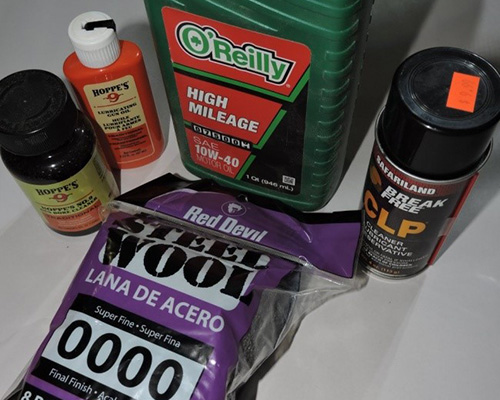
The reason 0000 steel wool is used, is that it is the finest and softest steel wool available, making it much less likely to damage the finish on the gun. This type of steel wool is normally used in doing fine finishes, to do the sanding between the next to last coat and the last coat or to rub out a defect in automotive paint, before applying a buffer.
It’s about the finest abrasive you can buy, short of a buffing compound. While the places where the rust exists won’t have that finish once we’ve removed the rust, at least the rest of the finish will remain intact, helping to protect the gun from further rusting.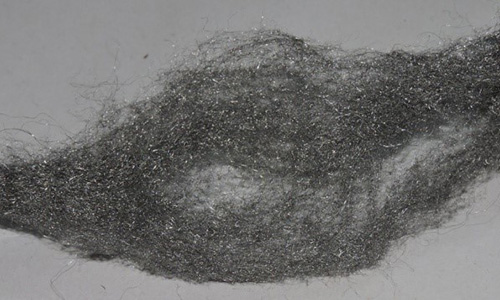
The oil can either be applied directly to the surface where the rust needs to be cleaned or to the steel wool.
The advantage of applying it to the steel wool is that you will have better control over where it is applied and how much is applied. In this case, there is a sticker on the other side of this gun slide, indicating that there is a laser sight installed.
Related: Brass vs Steel Ammo. Which Is Better For Preppers?
So, I’m trying to avoid getting the cleaner on that sticker and possibly damaging it.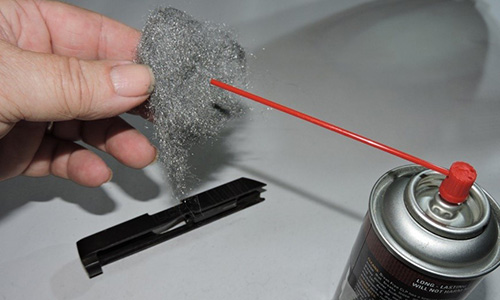
In most cases, it is easier to work in the long direction of the part being worked on; but that isn’t true in all cases.
On this slide, the front end, where the worst pitting is, is smooth, so it makes sense to work rubbing the steel wool back and forth along the long direction of the slide.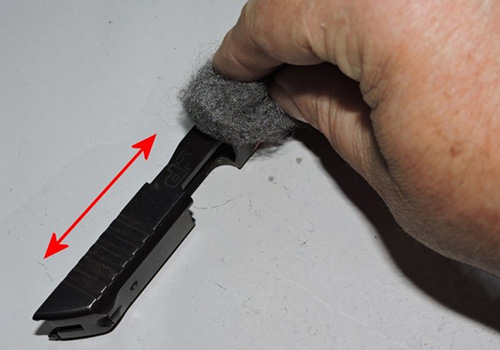
But there is also some rust on the back of the slide where the grips for racking the slide are located.
It is more or less impossible to remove the rust by working across those grips, it is necessary to work across the slide, in the direction that the ridges of the grips are going.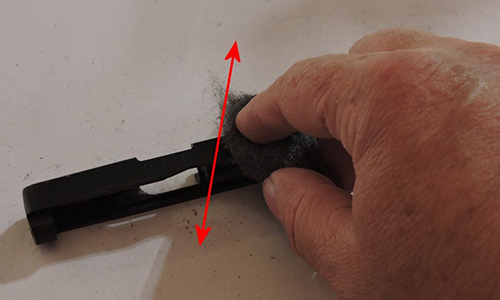
There may be some cases, in which it is necessary to work in multiple directions, such as where there is checkering. The point is to make sure that the rust is removed from all surfaces.
This doesn’t require a lot of pressure, as the rust is much softer than the steel and breaks up easily. Nor does it take very long. I was able to remove the rust from this slide in a matter of only a few minutes.
The left-hand picture is the same one as above, showing the rust and pitting on the slide. The right-hand picture is after working on it to remove the rust. It looks darker, because of the oil on the slide; but there is no pitting. Nor can I see any pitting when looking at it with a magnifying glass.
It may be possible, in some cases where the rust is worse than it was on this handgun, that there will be obvious bare patches, where there is no finish, after the rust has been removed.
That can be protected by keeping the gun well-oiled. If the gun is to be stored for some time, then it would be a good idea to put an oil-soaked rag around it and then cover it with plastic, much like the military used to have firearms manufacturers cover guns with cosmoline and tar paper to protect them from rusting.
Another thing to consider, if there are patches where the finish is gone, is to have the part refinished. There are a number of shops that offer this sort of service.
Just be sure to check them out thoroughly before selecting one. You want to be sure that you can count on them to return your gun’s parts.
You may also like:
The Collapse of Journalism and the End of Free Speech in America
Why You Should Never Hide Your Survival Stockpile In Your Basement (Video)

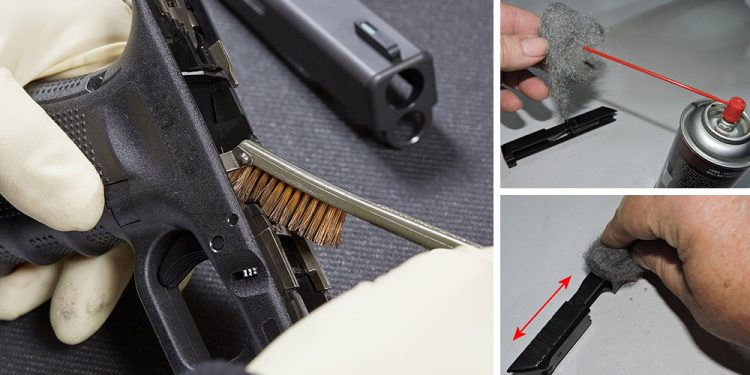
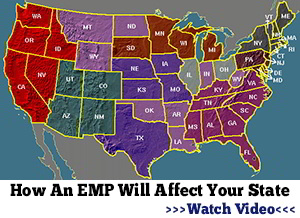













The earth is in melt down. I need to have my gun fixed or refinished. What do you do.?
I carry a 9 MM Kel Tec and it stays dirty most of the time. I don’t care if it looks ugly or if the finish is gone and the person that is being shot, won’t care if it looks good or bad. As long as it fires.
Cleaning is good but looks are not important to me.
Get a Revolver less to contend with. But still will need some cleaning and lube.
If you run out of lube because there is none to be found, what would you use instead of lube.
Spit
Fat from a kill
Lard
Ear wax
Water
Plant base
Tree sap
Honey or Bees wax
Just saying, But what would you use.
Think and put it in your post. I’m curious…
Red ant. Correct me if I’m wrong but Kel tecs aren’t exactly known for dependability .
As far as what else would I use us a great question. As I was recently thinking if any stored food oils ( olive oil for example ) have gone rancid, they could still be used in several applications, and I would definitely use it. I’d rather any of my rifles or handguns smell like a burrito and still be able to function.
@ Exodus 20 / Deuteronomy 5
I fill that any gun that in some way that can fire a round is a good gun to have. I like my little Kel Tec. It was cheap and I put it thru a lot. It sets between my seat in my truck. It stays dirty and is worn from using it as a tool sometimes, a Hammer and a door stop on my truck. But every time I need it, it fires very well. Really have not cleaned it in about a year. It works for me. I have some guns that are very expensive and some that are junk. But they all will fire a round when needed. I like my 38 special, nickel plated. it was made in the 70 as the numbers indicated on the Smith and Wesson web page. But I do have a High Point 45. it is my best gun of all. It has a very large frame and the grips are large enough for my hands. Most guns are to small for my hands and I have issues with that. But I think it is a good gun to own.
As far as any old oil that I have it can be used as a lubricant for anything I need it for. My guns, car doors or anything that is squeaking, or that may need to be lubricated. But I save all my old cooking oil or lard and make bio diesel. But anything will work as a lubricate. Even Water…
Would not recommend water, but in a worse case scenario, you could dip your gun in water just to maybe get it to work, with the water. Anything is worth a try when you are in the shit…
Most cooking oil is rancid even before you or me buy it anyway. That’s just how it is.
I bet you could use Jelly and other things that you are not aware of. But maybe you can try some things and then let us no how it worked. I will be happy to check back and see how it comes out. I do a lot of testing on a lot of different things my self.
I think the olive oil would smell more like a pizza in stead of a burrito. LOL. Better be careful people may think you are cooking something good and it’s your guns that are smelling. LOL
So let me know if you do testing on some of this that we are discussing.
Hey just be aware if you use and food oils , keep you dogs a way, they will lick it clean.
Exodus: Sometime ago in a discussion about expired cooking oils I recommended using them for a variety of purposes including lubricating one’s firearms. A light coating of any cooking oil that comes immediately to mind would do in place of some specialized firearms concoction. The only exception I might envision would be a rapidly firing automatic weapon or a small bore cannon. Since most of us won’t have such firearms in our armory, we should be able to use cooking oil without worrying about whether the objects of our fire think we are cooking up pizzas. As I think about it, perhaps that would be a successful ploy to draw them into our sights if they thought we were busily engaged in cooking up some pizzas. I would most definitely not recommend heating pepperoni on the barrel of your AR, however. There is too much salt in pepperoni to allow it to cook on the barrel of your AR or worse yet the barrel of your faithful 1944 Harrington & Richardson M-1.
What one has to watch out for is oils that have a high salt content. Someone wrote an article about how to use bacon fat and recommended it for firearms lubrication. That was a serious mistake in my view. Bacon fat has a very high salt content. Run a patch lubricated with bacon fat down your bore and tomorrow morning I guarantee that you won’t be able to see down your bore.
In 1957, as I was at the rifle range shooting for my yearly qualification with the rifle, a typhoon was approaching Okinawa. The last day as we fired for qualification, we fired in heavy winds and the start of the rains that usually accompany typhoons. Striking a squad tent in gale force winds and rain is a lot of fun, let me tell you. At that time in the Marine Corps we were still firing corrosive primed ammunition left over from WWII and Korea. As the arrival of the typhoon was upon us by the time we secured the range and boarded the six-bys to take us back to our base camp, it was pouring rain and our M-1s were completely unprotected.
When I arrived back at camp, I immediately set to cleaning my M-1. As I turned the piece upside down, water poured out of the barrel. The first patch I ran through the bore came out a bright rust orange. The combination of slightly salty rain water and corrosive priming had already started to form rust in the bore. I did manage to get it cleaned and oiled but for the next few days I had to clean the bore and the gas cylinder to remove a light coating of rust that kept forming.
Moral of the story is: Using alternative lubricants, be positively sure that they aren’t contaminated with salts before applying them to any firearm that you might be lubricating. Lard or tallow would be fine as long as none of the fat used in making those substances didn’t come from smoked or otherwise treated meat.
Some of our forefathers used bear grease to lube their black powder firearms and it worked well. However, that was fresh fat that was rendered and didn’t contain anything but rendered bear fat, so it didn’t harm their black powder firearms.
If you collect gun lube right know. You will run out of ammo before you run out of lube. I fill there will be more guns laying around or you can find guns maybe after a fire fight some place. Go and collect them and save them.
No ammo, who cares if your gun is rusting.
How many rounds can you carry. Me only about 200 or 300 rounds or more plus all of your other gear. Have you ever put all your gear on and seen if you can carrie it all. I can’t, to be onest. There is a weight limit that your body can handle. I’m not young any more and can’t get around like I was when I was younger. My mind says I’m a bad ass but my body says your mind is lieing to you. I can still get it done but not like I used to. If you bug in, that’s good but remember, fire burns and your house is a match stick ready to be lite and how long can you fight a mob of scum bags. I know we will give it hell for sometime but how long can you go. Hope you have some more people that can help, but can you trust them. Remember there is NO law in forcement. Hate that word. (in forcement). Even the people that you train and prep with may become your enemy.
Remember how many guns you own and they all have a different calibers. Better remember you just might be in some ones cross hairs. Pop your dead. Now you super bad ass and very clean and lubricated weapon belongs to some one else.
I’ve been fixing rusty vhehicals for a very long time and just like any steel products that are in there raw state will start to rust. Your barrel on your weapon will do the same. It to is in a raw state.
Trust me, we talk a good game but when you are fighting for your life or for your family’s life you will not be worried about lubing your weapon and if you make it out alive. Then maybe you might get that chances to clean and lube it, better do it, only if you are not killed.
Please use tree sap
Tree sap of the coniferous varieties might act as paint, but certainly not as lubricant.
The biggest issue with most plant oils, especially farther north, are their tendencies to turn to plastic as they oxidize. This leaves a sticky mess that will collect dirt and gum up the works in cold weather. So for example, linseed oil is great for rust-prevention, but is sticky. Most other poly-unsaturated vegetable fats are likewise unstable.
Olive oil is an old standby for firearms. Coconut oil is a very stable oil, which can help with rust-prevention. A friend of mine recommends fish oil, rendered and strained, as a good all-around option.
Hi Red Ant
Jarhead here and the answer is simple. I’m one who plans ahead, not catches up.
I’d spend a few bucks and simply have the real stuff on hand, with some backup in the cool and dry basement. No important gun care cleaning, lubricating, swabs, bbl brushes, Q tips, old tee shirts, product costs so much one couldn’t have ample backup to last you through WWIII. Buy some each paycheck and in two months you’re done. Brick and mortal gun shops charge a premium given their overhead.
This works for almost everything.
Combat, SOG and spec ops guys know………….. “Fortune Favors The Prepared Mind”.
PS: High Point guns are heavy, ugly, large and cumbersome BUT they are RELIABLE!! Guy on YouTube TRIED to destroy one, Demolition Ranch guy I believe, left it in mud, one time actually SHOT IT with another gun, threw sand all over it, and it …………… STILL cycled and fired! I have the full size .45 with Hornady Critical Duty in it, and it just stays in the console of my truck as a hammer with a second loaded mag, and in addition I conceal carry. If someone breaks into my vehicle and steals it while in there, report it stolen, get another, and forget it. I have huge hands and like the HP given the good strong purchase I get with it. I did put some strips of the skateboard super sticky traction tape (cuts with scissors easily to shape) on it for a zero slip surface.
I truly hope I NEVER need to draw any gun, but if I’m sure I’ll die if I don’t, it’s on.
In closing, I’d still clean and lube my gun after every couple hundred rounds, and wipe it down with a soft cloth sprayed with CLP or something. Not that hard and pays dividends. The HP are a pain to take down but one can still clean it some, bbl, chamber, ejector, stuff you can get to — but every 500 rds take that baby apart. Your life is worth it.
I have my Grandfather’s 16 ga shotgun. It hasn’t been fired in fifty years and the barrel is “pitted” I just want to restore it. Don’t shoot it. Can you tell me how to restore it?
Restoration is very expensive. I am guessing that your grandfather’s 16 ga. shotgun is a break open single shot. Those guns were not very expensive to begin with and they have not increased much in value over the intervening 50 years. Full retail for such a used gun would not be much over $100. It is easy to exceed $100 in gunsmithing fees. I would suggest getting a shotgun cleaning rod and instead of running cloth patches down the bore, run a bronze 16 ga. bore brush down the bore. You can wrap 4 ought steel wool around the bore brush to assist in cleaning the bore. I would use Kroil penetrating oil to clean the bore. It will penetrate under the rust and help loosen it. If there is lead in the bore from shooting lead shot, there are bore formulas designed to remove lead. Finally, you can polish the bore using a bore mop and jewelers rouge mixed with oil. Jewelers rouge is used in fine polishing. There are other oil based very fine polishing mediums that can be used to polish out a bore. If the blueing is worn on the outside, you can buy cold re-blueing compounds that do a credible job of restoring worn blueing. Be sure to follow the directions carefully. Acetone is a good degreaser to use before re-blueing. All of the supplies mentioned can be purchased on line from Brownells, Midway or other other on-line shooters’ supply houses.
If your grandfather’s 16 ga happens to be a double barrel and has the name Parker on it, get it appraised. It may be worth more with nothing done to it than it would be worth after you have dropped significant money restoring it. Too frequently, unknowing owners spend a lot of money restoring a firearm that significantly lessens its value to a collector. Unless your grandfather’s 16 ga. is the break-open single barrel Harrington & Richardson model, check its value before undertaking restoration work. That seems counter-intuitive but to many collectors, the wear of honest use makes the gun more valuable than a “restored” piece that has had all the wear of half a century or more of field use removed.
Restore is a relative term. To make it look “brand new” and “function” like new, 1st you need to know what you have and what mechanical condition it’s in. If it is a desirable make and model, I suggest JUST cleaning it and oiling it. until a pro can give you advise. If it’s a store brand, that you are sentimental about, and want to do the work yourself- 1st gets some hands-on advise on honing and polishing the bore ( just because it shines don’t make it safe to shoot), and on sanding/finishing wood, and polishing and bluing outside metal. There are some cold blues that can be made to look good, and oil finishes that look good on wood. take time to investigate, learn and give it a try, lots of info out there….
Metal filler and sand it in
Lard, it lays down like oil. Its free from cooked meat. Wax gets hard and causes a build up. Tree sap hardens as it dries out, this would be the absolute worst idea. Water? Water runs and fills every where there is air then loves to produce rust in areas you can’t see. If you have dirty guns water will usually make mud which is not popular as a lube or rust preventative.
I walnut know about spit. You could experiment with it but does have some of the properties of water. It would be better used for general cleaning not lube.
Brass wool is better to use than steel wool.
Best to get a professional to do that. While you still can.
Good luck.
Why bother its a 50 dollar shotgun with a non popular caliber.
As a gunsmith myself just sand it to bare metal and get metal filler and get the pockets filled and smooth it out. Let it cure up and have someone cera coat it any color you want.
I have found that the Eberhard Faber #317 typewriter eraser sharpened to a fine point makes a good rust remover in small, hard to get to places. a tiny drop of jewelers rouge in oil will help remove that rust in the serrations on the slide. In the even you can’t find that particular eraser — who uses a typewriter these days — any fairly hard surfaced rubber eraser that can be sharpened in a pencil sharpener will suffice. I have several lifetimes’ supply of typewriter erasers left over from the old days which I had to have in order to handle all the mistakes I made, so I haven’t shopped for erasers in over 20 years. Lacking a supply of typewriter erasers, a toothpick with jewelers rouge will work almost as well. For larger areas I use a popsicle stick with my old standby, jewelers rouge in oil.
I found Kroil penetrating oil works good in removing rust but don’t leave it on too long as it can remove blueing too if left on too long. Don’t let it soak overnight as you might with a rusted screw.
If you happen to remove some blueing, don’t despair. I have had good luck with cold bluing compounds but be sure to follow the instructions carefully. It won’t exactly match 100 year old hot bluing, but it will be a lot closer than bare steel. Note that all amateur “restorations” lower the value of an expensive firearm. If one wants to retain the value of an expensive firearm, it is necessary to bite the bullet and hire a professional who has experience in restoring firearms. You may think your work looks pretty good but to the discriminating eye of a collector, your amateur efforts with cold blueing will significantly lower the price of that first generation Colt single action .45.
I went to Amazon and found these Faber-Castell Perfection Eraser Pencil with Brush (3-PACK) which from the reviews would seem to have replaced the #317. I see it is no longer Eberhard Faber but Faber Castell these days. If you want to try the eraser rust remover scenario, I think these might do the trick. Remember, in all efforts to remove rust from a polished surface, gently, gently, gently.
As I was accessing this site to see other comments that had been posted, the name of the jewelers rouge that I was talking about suddenly came to mind. Sometimes it takes a while to access my older data banks. I have a jar out in the garage, but the original container gave up the ghost and it now resides in a label-less jar. That dangerous, I know and part of my on-going to-do list is labeling all the chemicals that I have left over from the print shop that are in non-labeled containers. However that is not an A category priority, probably more like an M category priority. I know it is going to come back and bite me one of this days but so many things to do, so little time.
The name of the jewelers rouge that I used in my print shop 20+ years ago is Putz Pomade. It is available on Amazon, of course, and is paste or liquid. I always used the paste. You will see that it is listed as a roller deglazer. That is what it is sold for, to deglaze rubber printing press rollers. It also serves as a fine polish for metal parts, particularly taking rust off. I presently use it when I want to remove stains from non-stainless steel knife blades. My apologies for not remembering the name in the prior post.
I have a Molasses Tank that I use for general rust removal.
Never used it with my firearms though.
Just a teacher’s comment. Steel wool this fine is called ‘four aught’ not ‘four ott’. “Aught” being the archaic word for ‘zero’. Reference King James Version of the Bible…
Aught, nought, naught, and ought, my goodness, I can’t keep ’em straight either.
Wait a minute. I resent the statement that “aught” is an archaic word. Perhaps it is not in as common usage as it once was, but some of us mature folks still use the word aught, especially when discussing the size of shot or other specialized topics. I also understand that the younger generation has trouble understanding a quarter past the hour or half past the hour, so perhaps it is more a lack of education at the primary school level that has lead to the abandonment of certain precise wordage.
If your 16 Ga. is fluid steel barrels, or barrel, which I would ‘assume’ to be the case, all is well.
Some of the older firearms, had twist steel barrels, which had patterns, depending on how the steel was hammered. They were not meant for modern shells. These are still to be found, how
ever, the ones I have seen, were in 12 gauge, and were doubles.
Good luck with your project.
Good Advice, Carl. I had forgotten that there are still a lot of older damascus or twist steel singles and doubles out there. They really are only suitable as wall hangers these days. Perhaps if thoroughly checked out by a gunsmith who knows what he is doing, they can be safely fired with black powder loads, but firing smokeless powder loads in damascus steel shotguns is generally not recommended.
For old time upland game hunters, like guys my age, the 16 ga. was considered the ideal shotgun for hunting upland game. For scientific ballistics reasons that I can’t explain lucidly inasmuch as I don’t fully understand them myself, the combination of shot weight and shot column formation in the 16 ga. is supposed to be a more ideal combination than any other shotgun size. I am paraphrasing opinions I have read by folks who claimed to know what they were talking about. I can miss just as easily with a 16 ga. as any other gauge, so I cannot demonstrate the nuance that ballisticians talk about. It also was lighter to carry in the field all day as compared to a comparable 12 ga.
My first shotgun was a 16 ga. Harrington & Richardson break-open, single shot. Perhaps similar to Walter’s grandfather’s shotgun. HIs grandfather and I may have been contemporaries.
Rub it with an old copper penny.
After removing the rust and oils, if it was blued, consider using ‘Cold Blue’ . A couple of coats then oil as usual.
Is Illini Warrior M.I.A.?? This would be a great topic for him to tell everyone how wrong they are. Remember he knows it all.
Come to think of it he may be related to my wife.
No his but buddy red ant is
When I was a mechanic in the Army, those of us in my section had a quicker more effective cleaning method.
We took our M16s , and later M4s when they came into service, and after a day at the range would run them through our parts cleaner. Now if I could just remember the name of the stuff that was in there. Lol but then again, maybe exposure to that chemical us why I can’t remember. ?
I’ve never considered the steel wool so thanks something to add to the kit.
Several manufacturers now offer ultrasonic gun cleaning devices that use liquid cleaner to transmit the vibrations to the parts. The ones I have seen are mostly of a size to clean either handgun or bolts and assorted assemblies of shoulder weapons but not the barrel and receiver as one piece. There may be such available but I haven’t seen them. Like everything these days, they are not cheap but if you do a lot of shooting, they keep your guns clean at a minimal investment of time.
A auto parts cleaner among brake cleaners is terrible.
Ceracoating is a solid plan
Left Coast Chuck – Putz Pomade? Check your Yiddish-English dictionary and see if you laugh as loudly as I did at the implication.
MikeyW: Yes, I have always wondered at the name, but it has been a printing industry stalwart for over 50 years. I just used it and never researched the source of the name. I always knew a putz in yiddish was born loser and pomade in my lexicon was a greasy substance one used on one’s hair, especially if one were posing as latin gigolo. The pressroom Putz Pomade indeed has a petroleum based liquid in it which I always though was kerosene but could be a light weight oil of some sort. The abrasive is jeweler’s rouge, I believe, which is a fine abrasive used for polishing metals.
IN the pressroom, press rollers develop a glaze on them after miles of running with ink and solvents and all kinds of other chemicals on them while operating. We cleaned the press of ink and other chemicals with solvents and then let the press idle with the P.P. on the rollers for a period of time and then cleaned it off. It left the rollers once again soft and receptive to the ink and other chemicals that we used in printing. I use it for light rust removal on various metal parts. I also use it to polish non-stainless steel knife blades. I mainly use it because I have it on hand, left over from my print shop. No supplier will take back open chemicals and so They are in my storage shed and I use them occasionally. Nice thing, I had 99% IPA in my shed left over from my print shop and was able to share with close relatives who found in the early days of the plague that IPA was unobtainium. I reduced my 99% printer’s IPA to 75% for sanitation purposes.
Perhaps I will go on line and try to find out how the founder arrived at the name.
I went on line to see if I could determine the source of the name Putz Pomade. I learned that there was a relief pitcher who played in the 2007 Allstar game by the name of J. J. Putz. I don’t think he got much grief about his name as the article said he stood 6’5″. Putz in German apparently means water well. It is my understanding that Yiddish is actually what is called Low German as distinguished from High German (Inquiring minds wonder if there is such a thing as Middle German?) Also partially read the family history of the Myers family from Germany whose ancestor started manufacturing Putz Pomade, Also read a short bit about how to manufacture it. Very basically one starts with rust and heats it. It is still used in the printing industry for deglazing rollers and also for polishing the drums on electrostatic printing plate makers.
I did not learn why an early Myer named his product Putz Pomade. Maybe it translates better in German.
My husband just restored a flint lock from the 1800s. I wanted to keep it. The brass was gorgeous. The wood was so nice. It would have made a nice piece of art. He said he put too much of himself in it to hang on a wall. He sold it to someone who shoots it. My husband used a vinegar/Kroil oil (micro Kroil) mixture to soak the rusted parts. He use to use Wipeout products for the bore, but they have become too expensive.
People extract essential oil from plants (distillation maybe)… I can just see (or smell) my FN now smelling like spearmint.
That 16 ga Walter G. Links, Jr. is referring to could be one of those Browning Sweet Sixteen semi autos. They could definitely have been manufactured during his grandfather’s era. I always wanted one growing up, but settled for the 12 ga.
Thanks for letting me know about black oxide finishings and how they’re a good way to prevent rusting in guns. My father wants to restore grandfather’s old guns and make them look more modern and durable. It seems to be that getting a black oxide finish would be the best way to achieve that as it’ll make it an aesthetic look while giving it a finish that is sure to last long.
Great article
keep spreading the word , preserve , protect , Stand your ground
speak up
speak out
stop the Evil crime spree heading your way
stay alert
stay armed to the teeth for the morans who will come to take your s and commit evil in and atempt to subdue you and your s
preparation is the only answer
Oil over time evaporates and for that reason I use silicon to wipe them down. Over the years it seems to work very well and it does not evaporate. The bores I fine coat with good quality gun oil once a year or as often as I shot them.